Providing an account of the trial of Jesus presents challenges unlike that for any of the other trials on the Famous Trials Website. First, there is the challenge of determining what actually happened nearly 2,000 years ago before the Sanhedrin and the Roman prefect of Judea, Pontius Pilate. The task is daunting because almost our entire understanding of events comes from five divergent accounts, each of which was written by a Christian (who did not witness the final days of Jesus directly) for a distinct audience from fifteen (at least) to seventy years after the trial. Second, there is the challenge that comes from knowing that readers of this account are likely to have prior understandings of trial events that come from their own religious training--and that any account of the trial provided here that varies substantially from these prior understandings may not be easily accepted. Nonetheless, I believe the trial of Jesus merits analysis for the simple reason that no other trial in human history has so significantly affected the course of human events.
The Setting
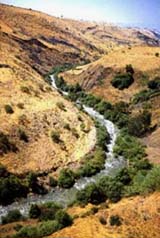
In 63 B.C.E. the Roman general Pompey captured Jerusalem, and in so doing put an end both to the independent Jewish state of Palestine and eight decades of rule by the Hasmonean dynasty of high priests. Rome began appointing the high priests that served the Temple in Jerusalem. High priests from then on juggled the religious interests of Jews and the political interests of Rome, at whose pleasure they served.
Seven decades after Rome assumed control of Palestine, in 6 C.E., growing Jewish opposition to Roman laws relating to the census, taxation, and heathen traditions boiled over. Especially despised was the Roman imposition of a census of property for tax purposes. Ancestral land held an exalted position in Jewish ideology. Many Jews feared that the new laws would lead to its appropriation by Rome. Jewish uprisings in protest of the laws led to the crucifixion of over 2,000 Jewish insurgents and the selling into slavery of perhaps 20,000 more. The most intense opposition to Rome came from an area of Palestine called Galilee, which was the center of an armed resistance movement called the Zealots.
The riots of 6 C.E. and recurring outbreaks that followed caused Roman officials to see Jewish nationalism and religious fervor as threatening to law and order. When Herod Antipas, the Roman ruler of Galilee, constructed a new capital city, Tiberius, on the western shore of Galilee in 19 C.E., he might have expected trouble from the peasant population forced to meet heavier tax burdens to pay for it. In any event, trouble came, as two significant Jewish religious movements were born in the next decade in the region of northern Palestine under his rule.
The first important movement to arise in Galilee was led by the apocalyptic visionary, John the Baptist. The Baptist called upon his followers to confess their sins, live an ascetic lifestyle, and prepare for the imminent coming of an avenging God. To the purification process offered in the Temple, he presented a radical new alternative: a ritual immersion in the waters of the Jordan River.
John the Baptist's growing popularity among the peasant population alarmed Herod Antipas, who likely feared that the new movement, with its promise of apocalyptic intervention, could lead to rioting. Antipas made a preemptive strike. He arrested and executed--beheaded, according to Biblical accounts--the Baptist. The execution of John the Baptist may have deeply influenced one of his early disciples, a young man from Nazareth that he had baptized in the Jordan River (Mark 1:9-11), Jesus.
The execution of John the Baptist is likely to have had a profound effect on Jesus. God's non-intervention might have caused Jesus to modify the apocalyptic vision of John the Baptist--which was probably a product of the perceived hopelessness of the peasants' plight--to one that emphasized change in the structure of political and religious institutions. The teachings of Jesus, who began his ministry around 28 or 29 C.E., describe an ideal world, a world that might exist if God--and not Caesar or the high priests--had his way. Jesus spoke primarily of the need to change the here and now, and less of need to ready oneself for the arrival of an avenging God. Needless to say, a religious program of the sort presented by Jesus would likely be seen as threatening by powerful beneficiaries of the status quo, from Roman leaders to Temple officials.
Antipas might well have preferred Jesus dead, but he had to balance that desire against popular resentment related to his execution of the popular John the Baptist. For that reason or some other, Antipas did not move to suppress the Kingdom of God movement led by Jesus.
The Crime
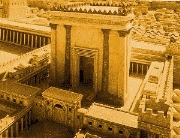
To understand the crime which likely led to the arrest of Jesus, it is first necessary to understand the role of the Temple in first-century Jewish life. The Temple in Jerusalem served dual purposes. It was both the revered center of religious life--a place for prayers and sacrifices--and a central bank, a place for taxes and tithes.
Nothing provoked greater anger among observant Jews than acts perceived to be defilements of the Temple, as other dramatic incidents in the two decades following the death of Jesus make clear. In 41 C.E. for example, Emperor Caligula ordered Petronius, the new Syrian governor, to install statues in the Temple depicting himself as Zeus incarnate. Thousands of unarmed Jews responded by lying prostrate and offering themselves to Roman soldiers for a mass slaughter. Other Jews threatened an agricultural strike. Petronius backed down and Caligula's timely assassination ended the matter. Less than ten years later, a soldier watching over Jews celebrating the Passover at the Temple (according to historian Josephus, writing in about 90 C.E.) "raised his robe, stooped in an indecent attitude, so as to turn his backside to the Jews, and made a noise in keeping with his posture." This disrespectful gesture led to a riot and stampede that killed vast numbers of people: "Troops pouring into the porticoes, the Jews were seized with irresistible panic and turned to fly from the Temple and make their escape into town. But such violence as was used as they pressed around the exits that they were trodden under foot and crushed to death by one another; upwards of 30,000 perished, and the feast was turned into mourning for the whole nation and for every household into lamentation" (Josephus, Jewish Antiquities).
Roman leaders paid close attention to Temple activity. Any threat to Roman power over the Temple--even a symbolic threat--was dealt with harshly, as seen by the response to an incident around 5 B.C.E. When a group of about forty young men climbed to the roof of the Temple and began chopping down a golden eagle, seen by them as a symbol of Roman control, the men were (according, again, to Josephus) arrested "with considerable force." Those observed on the Temple roof were burnt alive and the others merely executed.
It seems clear that the primary cause of the trial and execution of Jesus was his role in an incident at the Temple in Jerusalem. The incident occurred in April, 30 C.E. (or possibly in 33 C.E.) during Festival time, the period including the Day of Passover leading into the week of the Unleavened Bread. The Festival brought huge numbers of Jews into the city to celebrate the Exodus, the leaving of Egyptian oppression and the arrival in the Promised Land. Romans had to understand the special risks presented by such a commemoration: large concentrations of Jews celebrating their former freedom in a time of new oppression--this time by Rome, not Egypt.
Jesus probably came to Jerusalem about a week before the Passover, most likely for the purpose of carrying his message of the imminent coming of the Kingdom of God into the heart of Israel--though possibly, like so many thousands of other Jews, simply to celebrate the highest of religious days.
Gospel accounts describe the participation of Jesus in a protest directed at some of the commercial practices associated with the Temple. The practices offended many Jews. According to Matthew, Jesus had complained, "My house shall be called a house of prayer, but you have made it a den of robbers" (Matthew 21:13). Mark and John tell of Jesus overturning the tables of money-changers, those persons who converted coins bearing images of the emperor into Tyrian silver coins, the only form of coin acceptable for donations. The Gospels also describe Jesus driving the pigeon-sellers (the birds were used as sacrifices by worshipers) from the Temple. It is hard to imagine that such a dramatic action would not have brought an immediate response from armed Temple guards, so it is likely that the gospels exaggerated Jesus' actions. Whatever the precise nature of his actions, they were almost certainly accompanied by words--perhaps including a prediction that the Temple would fall unless reforms were instituted to bring the Temple back to its central religious mission.
At a time of high tension such as the Passover festival, it is likely that any subversive action in the Temple--even action of a symbolic nature--would provoke a strong response from high priests and Roman officials. It did.
Arrest and Trial
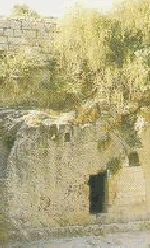
The four gospels place the time and scene of the arrest of Jesus as night in the garden of Gethsemane, an olive grove just west of Jerusalem on the Mount of Olives. The arresting party most likely consisted of Temple police dispatched by Caiaphas, the high priest. The party may also have included, as John reports, a Roman cohort under its commanding officer--but it is hard to believe that deployment of so large a force (a cohort consisted of about 600 men) would be seen as desirable to effectuate the arrest of a single individual.
The role in the arrest of Jesus of Judas, a follower of Jesus, is a matter of historical debate. Jesus Scholar Bart Ehrman, author of Jesus: Apocalyptic Prophet of the New Millenium, notes that prior to the disturbance at the Temple, nothing Jesus had said suggested he thought himself the Messiah or "King of the Jews." Asking the question, "So where did the authorities get the idea that he did?," Erhman suggests an answer: Judas. As a motive for his betrayal, Erhman identifies two theories. The first theory holds that Judas became disillusioned when he realized that Jesus "had no intention of assuming the role of a political-military messiah." The second theory holds that Judas "wanted to force Jesus' hand" and believed that his arrest would lead to a call for an uprising against Roman rule. Other scholars such as John Crossan, author of Who Killed Jesus?, have a somewhat simpler explanation. Crossan speculates that Judas may have been captured in the incident at the Temple--and that he might have been pressured to tell authorities who had caused the Temple trouble, not just where the guilty party might be found.
The gospels provide three very different accounts of the trial of Jesus. Peter, possibly writing as early as the 40s C.E., describes a single trial scene involving Jewish, Roman, and Herodian officials. Mark, writing in the 60s C.E., describes two separate proceedings, one involving Jewish leaders and one in which the Roman prefect for Judea, Pontius Pilate, plays the key role. Matthew and John's account generally support Mark's two-trial version. Finally, Luke--alone among the gospels--adds a third proceeding, having Pilate pass the buck (for jurisdictional reasons) and sending Jesus to Herod Antipas.
Figuring out what really happened in the trial of Jesus is enormously difficult. Two surviving non-Christian accounts, one by Roman historian and another by a Jewish historian, confirm that Pilate ordered the execution of Jesus--but beyond that, offer few details. Writing in the late first-century, Tacitus offered this comment:
Christus [Jesus], from whom the name had its origin, suffered the extreme penalty during the reign of Tiberius at the hands of one of our procurators, Pontius Pilate, and a most mischievous superstition, thus checked for the moment, again broke out not only in Judaea, and the first source of the evil, but even in Rome, where all things hideous and shameful from every part of the world find their centre and become popular.
The Jewish historian, Flavius Josephus, writing in the 80s or early 90s C.E., indicated that both Jewish leaders and the Roman prefect played roles in the crucifixion of Jesus:
About the same time there lived Jesus, a wise man for he was a performer of marvelous feats and a teacher of such men who received the truth with pleasure. He attracted many Jews and many Greeks. He was called the Christ. Pilate sentenced him to die on the cross, having been urged to do so by the noblest of our citizens; but those who loved him at the first did not give up their affection for him. And the tribe of the Christians, who are named after him, have not disappeared to this day.
Josephus would have no reason to attribute a non-existent role to "the noblest of our citizens," so it is probably safe to assume that Jewish leaders did encourage Pilate to crucify Jesus. Questions remain, however, as to what form that encouragement took--and how willingly or unwillingly Pilate responded to their encouragement.
The gospels report that Jesus was brought before high priest Joseph Caiaphas and the Sanhedrin, the Jewish supreme governing council and court. Mark and Matthew report a trial at night in the house of Caiaphas, whereas Luke explicitly states that Jesus was tried in the morning before the Sanhedrin. Some scholars doubt the accuracy of the gospel accounts. They note that Jewish law prohibits both capital trials on the eves of a festival and trials by night. (Other scholars answer that Jewish law might have been different then.)
The gospels point to different sources of initial concern among the Jewish authorities. Mark suggests that the Jewish authorities were concerned primarily with the confrontation Jesus had with traders in the Temple, while Luke's account identifies their primary concern as his teachings in the Temple. John, meanwhile, points to a fear among Jewish authorities that Jesus' rising popularity could lead to an uprising that would provoke a violent response from Rome.
All four Biblical accounts agree, however, that Caiaphas and the Sanhedrin ultimately condemned Jesus for blasphemy. The gospels record that when Caiaphas asked Jesus whether he claimed to be the Messiah, he replied, "I am" (Mark 14:62) (or "You have said so" (Matthew 26:64) or "If I tell you, you will not believe" (Luke 22:67-8) or "You say that I am" (John 19:7)). Although the Mishnah, the Jewish lawcode assembled around 200 C.E., defined blasphemy more narrowly as speaking the sacred name of God (YHWH), the gospel writers suggest a looser first-century construction of the term, one that includes a variety of serious theological offenses.
After his condemnation by Jewish authorities, Jesus was brought--under all but Peter's account--to the Roman prefect of Judea, Pontius Pilate. The reason, according to John, was that the death penalty was not an available option for the Sanhedrin under Roman law. (It should be noted, however, that the Sanhedrin operated during these times with less than complete independence to implement Jewish law, having a dual political and religious status.) There is, however, strong reason to believe that Jewish authorities could, had they so desired, executed Jesus. The well-substantiated executions--by stoning--of two first-century Christians, Jesus's brother James in 62 C.E. and Stephen, show that capital punishment was--at least within a few decades of Jesus' trial--practiced by Jewish authorities. Moreover, Temple inscriptions from the period warn of death to Gentiles that pass into certain restricted areas.
Biblical accounts of the trial before Pilate are largely fictional, according to most scholars. It is unlikely that any supporter of Christ would have been in a position to record any questioning of Jesus by Pilate that might have taken place.
Whatever their basis, the gospels portray a Pilate initially unpersuaded of Jesus' guilt. For example, in Mark, after Pilate asks Jesus about "the many charges [the chief priests] bring against you," Jesus makes "no further answer" and "Pilate wondered." Later, Mark reinforces his suggestion of a reluctant executioner when he writes, "For [Pilate] perceived that it was out of envy that the chief priests had delivered him up." Finally, Mark makes Pilate's doubts explicit by having him almost beg the crowd to release Jesus over the (almost certainly invented) prisoner Barabbas. Pilate asks the crowd to explain their thirst for the blood of Jesus: "Why, what evil has he done?" Pilate allows the crucifixion of Jesus, in the gospel accounts, not out of a conviction that Jesus did anything wrong, but only to "satisfy the crowd." If there were still any doubt about Pilate's doubt, the gospels report that after authorizing his execution, he "washes his hands."
The gospel accounts so transparently attempt to present the chief priests--and not Pilate--as the more blameworthy party that scholars have raised numerous questions about their accuracy. Scholars have paid special attention to the incentives of Mark because he wrote the earliest of the four gospel accounts in the Bible, and Matthew, Luke, and (to a lesser extent) John based their accounts on his. The scholars point out that Mark--writing at a time of Roman prosecution of Christians and for a largely non-Jewish audience--had incentives to present a story that would minimize the risk of condemnation by Roman authorities and maximize his prospects for winning converts to Christianity from among the Romans in his audience. How could Mark, these scholars ask, possibly have known what Pilate "wondered" about Jesus' guilt or what he "perceived" about the purposes of high priests?
Pilate was a powerful figure. If he had reservations about killing Jesus, he certainly could have taken him back to Caesaria for trial or referred his case back to the Sanhedrin for possible punishment under Jewish, not Roman, law. The fact that Pilate did not do so suggests that he was pleased to accede to the urgings of Jewish leaders and crucify Jesus. Anyone calling himself "King of the Jews" would have been seen as trouble by Roman officials. Further evidence that Pilate bore primary responsibility for the execution of Jesus comes from Paul in his letter to the Corinthians, written in the early 50s C.E., where he says that Jesus had been crucified by "the princes of the world"(I Cor. 2:8).
It is altogether possible that there not only was no trial before the Sanhedrin, but none before Pilate either. Pilate and Caiaphus worked long--and probably therefore--well together. They very likely might have had standing arrangements for dealing with subversive action during festival time. These arrangements could have included, according to Biblical scholar John Crossan, "instant punishment with immediate crucifixion as public warning and deterrent." Crossan argues, "There would be no need to go very high up the chain of command for a nuisance nobody like Jesus, no need even for a formal interrogation before Caiaphas, let alone a detailed trial before Pilate." Ehrman agrees, writing, "If someone was perceived to be a troublemaker, there was no need to follow anything that would strike us as due process, at leat for the non-Roman citizens of the provinces." Ehrman adds, "There would have been no reason to conduct a criminal investigation out in the open and ask for the crowds' opinions."
Pilate had little concern for Jewish sensibilities. During his ten-year tenure (from 26 C.E. to 36 C.E.) as prefect, Pilate had numerous confrontations with his Jewish subjects. According to Jewish historian Josephus, Pilate's decision to bring into the holy city of Jerusalem "by night and under cover effigies of Caesar" outraged Jews who considered the images idolatrous. Pilate provoked another outcry from his Jewish subjects when he used Temple funds to build an aqueduct. His lack of feeling was accompanied, according to Jewish philosopher Philo writing in 41 C.E, by corruption and brutality. Philo wrote that Pilate's tenure was associated with "briberies, insults, robberies, outrages, wanton injustices, constantly repeated executions without trial, and ceaseless and grievous cruelty." Philo may have overstated the case, but there is little to suggest that Pilate would have any serious reservations about executing a Jewish rabble-rouser such as Jesus.
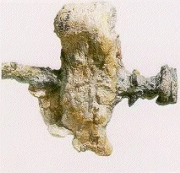
In some particulars, Biblical accounts of Jesus's punishment are consistent with what would be expected under first-century Roman law. Most obviously, the form of execution used--crucifixion--was a common one at the time when the convicted criminal was a slave, Jew, or other foreigner. (Romans were exempt from crucifixion, which was thought to be the most painful and humiliating of all punishments.) Crucifixion also establishes conclusively that Jesus was condemned as a violator of Roman, not Jewish, law. A capital sentence under Jewish law would have meant stoning.
Other aspects of the Biblical accounts of the execution that match common Roman practice include the flogging Jesus received at the hand of Roman soldiers before his execution, his carrying of the cross to the place of execution, and the guarding of the execution site by a unit of four Roman soldiers. The execution site identified in the gospels, Golgotha (meaning "place of the skull" in Aramaic), is probably accurate--although which of two possible hillsides north of Jerusalem might have been "Golgotha" is a matter of current dispute.
Unfortunately, horrific details of the crucifixion account, such as the nailing of the hands and feet of Jesus to the cross, also are probably true. In 1968, a nail-pierced heel bone of a first-century crucifixion victim was found near Jerusalem providing fresh evidence of Roman cruelty. The stripping of prisoners seems also to have been standard Roman practice, with the clothes and other small possessions of execution victims divided among the executioners. The humiliation of being hanged nude in a prominent place added to the punishment's intended deterrent value.
The Gospel of John reports that "the Jews did not want the bodies left on the cross during the Sabbath...so they asked Pilate to have the legs of the crucified men broken." This reference, obscure to most modern readers, is to what was considered a merciful act. Crucifixion is normally a painful and long death, with victims sometimes remaining alive on the cross for days. Leg breaking speeds the process by causing a rapid onset of asphyxiation or fatal shock. John's account indicates that Jesus was already dead when the soldiers arrived to break his legs. That may indeed have been the case, but Jesus's reportedly quick death--accounts vary from about three hours in John to six hours in Mark--would have been unusual.
Many other details in the gospel accounts appear to be added by early Christian writers to show the passion story as a fulfillment of Old Testament prophesies concerning the coming of Messiah. For example, four accounts (Mark, Matthew, Luke, and Peter) describe a three-hour period of darkness falling over the land beginning at noon on the day of crucifixion of Jesus. Luke refers specifically to a solar eclipse that lasted until three in the afternoon. It is possible to calculate backwards the dates and locations of solar eclipses, and it is clear that no eclipse occurred in Jerusalem at the time of the crucifixion. It is also clear from other sources that solar eclipses were, in the first-century, associated with human events of great significance. Josephus, Plutarch, and Pliny the Elder each report, for example, that midday darkness followed the assassination of Julius Caesar on March 15, 44 B.C.E.--although, again, it did not. Thus, a writer seeking to impress readers that the crucifixion of Jesus was the fulfillment of an historic prophesy would have been tempted to add the fictional element of a solar eclipse to his account. The reported words of Jesus on the cross are believed to also fall into the category of prophesy historicized rather than history remembered.
Several early sources indicate that crucifixion victims were typically left on their crosses, their bodies to be eaten by vultures and dogs. Friends of Jesus doubtless would have preferred a kinder fate for him, and it is possible that some of his supporters, or Jewish religious authorities believing "enough is enough," succeeded in obtaining permission to remove Jesus from his cross. If this happened, he likely would have been buried in a rock tomb, most likely one belonging to his family. It is also possible, however, that what happened to the body of Jesus is what happened to most victims of Roman crucifixions: it was devoured on the cross by animals. John Crossan, author of Who Killed Jesus?, finds the latter outcome the more likely:
I keep thinking of all those thousands of Jews crucified around Jerusalem in the terrible first century from among whom we have found only one skeleton and one nail. I think I know what happened to their bodies, and I have no reason to believe that Jesus' body did not join them....The burial stories are hope and hyperbole expanded into apologetics and polemics. But hope is not always history, and neither is hyperbole. In this case, as so often before and after, horror is history.
The Aftermath
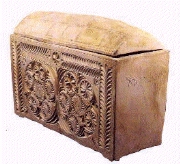
Within six years of the crucifixion of Jesus, Syrian governor Vitellius removed from power both of the men--Joseph Caiaphas and Pontius Pilate--most responsible for his execution. Pilate's repeated difficulties with his Jewish subjects was the apparent cause for Vitellius' decision to remove him. Rome ordered Pilate home to face complaints of excessive cruelty, which eventually led to his exile in Vienne, France.
Meanwhile, the followers of Jesus began to split into two branches. One branch, based in Jerusalem and led by the brother of Jesus, James, portrayed Jesus as a martyr for Jewish nationalism. The other branch, the so-called "Gentile branch," was led by the Apostle Paul who rejected the historical Jesus and largely created the version of Jesus found in the Bible today. In place of the historical Jesus, Paul--who had relatively little knowledge of the real Jesus--substituted a heavenly redeemer who emphasized transformation through love and inward faith. Paul spread his message among the Gentiles, winning converts to his brand of Christianity which did not require full observance of traditional Jewish law.
While the very earliest Christian writings saw the trial and execution of Jesus as the rejection of the Messiah, soon writings began portraying the execution has having a deeper meaning: It was part of God's plan to save humanity as prophesied in writings now comprising the Old Testament.
In 62 C.E., James was stoned to death. Eight years later, Rome captured and destroyed Jerusalem marking the end of the four-year First Jewish War. The "Jerusalem branch" of Jewish Christianity was effectively crushed (although small sects survived until around 300 C.E.), leaving Paul's "Gentile branch" as the Christian torch-carrier.
Over the next twenty-five years, the four Biblical passion accounts were written. Mark's version came first, and the Gospels of Matthew and Luke derived largely from his. John's version was written last, probably around 80 to 95 C.E. John, too, relied heavily on Mark, but is much more creative in his presentation than Matthew or Luke. All three non-Markan gospels also rely, most likely, on a now-lost second account of the trial and crucifixion story.
Most significantly, all four Gospel accounts, written to appeal to Gentiles in Rome and elsewhere, tell their stories in such a way as to make Jewish authorities--not Roman authorities--primarily responsible for Christ's death. By placing more blame than is deserved on the Jewish authorities of the time, these early Christian writers undoubtedly contributed to some degree to the growth of anti-Semitism with all of its tragic consequences. On the other hand by telling their stories as they did, in a form more likely to be well received by their intended audiences, they also made possible the long-term survival of the Christian faith, with all of its positive messages of love, hope, and faith.